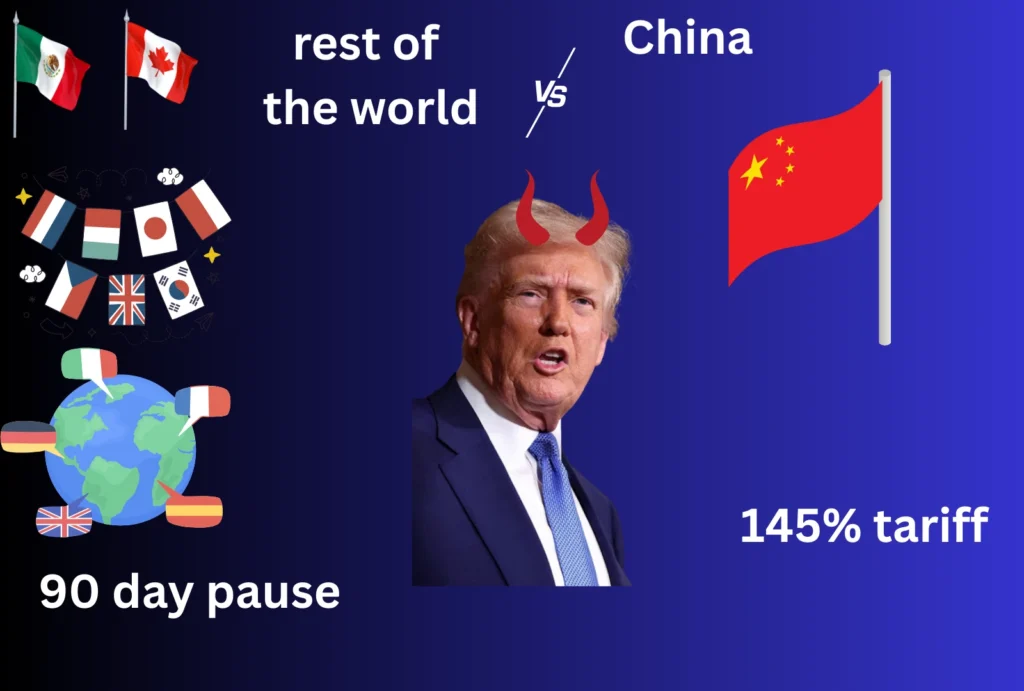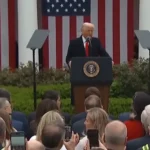April 12, 2025 – The United States has rolled the dice on one of the boldest trade moves in modern history, slapping a staggering 145% tariff on Chinese imports under President Donald Trump’s “Liberation Day” policy. Promising to revive American manufacturing and correct decades of trade imbalances, the tariffs have instead ignited a firestorm of economic uncertainty, threatening ripple effects across the U.S., China, and the global economy. As markets reel and tensions rise, the world braces for a potential trade war—and the U.S. faces daunting challenges at home and abroad. Will the tariffs hold at 145%, or could cracks in the strategy force a rethink? Here’s what’s at stake.
A Shock to the System: Why 145%?

Trump’s tariff, announced on April 2, targets China’s $400 billion-plus trade surplus with the U.S., aiming to make Chinese goods prohibitively expensive and boost domestic production. The White House calls it a “national emergency” measure to protect American workers, citing China’s dominance in electronics, pharmaceuticals, and critical minerals. But the sheer scale—145% on everything from iPhones to solar panels—has stunned economists, who warn of a cascade of unintended consequences.
For American consumers and businesses, the tariffs are a double-edged sword. Here’s how the U.S. could suffer:
- Skyrocketing Prices: With 40% of U.S. imports tied to Chinese supply chains, everyday goods—clothing, electronics, toys—could see price hikes of 20-50%. The Yale Budget Lab estimates a $3,800 annual hit per household, fueling fears of stagflation as inflation, already at 3.2%, climbs higher. A viral X post summed it up: “My Walmart cart just became a luxury purchase.”
- Supply Chain Chaos: Industries reliant on Chinese components, like automotive and tech, face disruptions. General Motors and Ford have warned of delays, while Apple, with 90% of its supply chain in China, is scrambling to diversify. Small businesses, unable to absorb costs, could fold—over 30% of U.S. retailers import heavily from China.
- Job Losses in Vulnerable Sectors: While Trump promises manufacturing jobs, economists argue short-term pain will hit harder. Retail, logistics, and agriculture could shed 500,000 jobs by 2026, per the National Bureau of Economic Research, as exports to China dry up and domestic costs soar.
- Stock Market Jitters: The Dow plunged 4% post-announcement, wiping out $6 trillion in S&P 500 value in days. Investors fear a prolonged trade war could spark a recession, with consumer confidence already at a two-year low.
- Political Backlash: Public support is shaky—only 39% of Americans back the tariffs, per Quinnipiac. As prices rise, even Trump’s base may sour, especially in rural areas hit by China’s retaliatory tariffs on U.S. crops like soybeans (down 15% in futures).
The 145% rate may not hold. Trump’s 90-day tariff pause for some allies hints at flexibility, and insiders suggest he’s open to deals if China offers concessions, like curbing fentanyl exports or opening markets. Posts on X speculate he’s using the high rate as a bargaining chip, with some analysts predicting a drop to 50-75% if negotiations progress. However, Trump’s insistence that tariffs are “doing really well” and his dismissal of critics as “weak” signal he’s digging in. If China retaliates further, he could double down, risking escalation.
China’s Pain: Resilience Meets Vulnerability
China, the tariff’s primary target, faces its own reckoning:
- Export Losses: The U.S. is China’s largest single market, absorbing $500 billion in goods annually. A 145% tariff could slash exports by 60%, per Goldman Sachs, hitting industries like electronics (Huawei, Lenovo) and textiles hardest. Coastal provinces like Guangdong could see unemployment spike.
- Economic Slowdown: China’s GDP growth, projected at 4.8% for 2025, could dip to 3%, a historic low. Beijing’s “national team” is pumping billions into domestic firms, but a prolonged trade war could strain its $3 trillion reserves.
- Retaliation: China’s response—125% tariffs on U.S. goods like aircraft, whiskey, and pork—aims to hit Trump’s heartland. It’s also courting the EU and ASEAN to offset losses, positioning itself as a free-trade champion. Xi Jinping’s call to resist “bullying” has rallied domestic support, but public unrest looms if jobs vanish.
Despite the pain, China’s resilience shouldn’t be underestimated. Its Belt and Road investments and pivot to markets like India and Brazil could cushion the blow. Still, a fractured U.S.-China trade relationship risks long-term stagnation for both.
The World Economy: Collateral Damage
The tariffs’ shockwaves extend far beyond bilateral trade:
- Global Recession Risk: The IMF slashed its 2025 growth forecast to 2.9%, citing trade disruptions. Developing nations reliant on U.S.-China trade, like Vietnam and Malaysia, face export slumps. Europe, caught in the crossfire, fears a 1% GDP hit if it’s forced to pick sides.
- Supply Chain Gridlock: From semiconductors to rare earths, global industries face shortages. Taiwan’s TSMC, a chipmaking giant, warned of production cuts, threatening everything from cars to laptops. Prices for lithium and cobalt, dominated by China, are up 20% since April 1.
- Currency Shifts: The yuan fell 5% against the dollar, while the euro and yen wobble. Some X users claim the tariffs could hasten “de-dollarization,” as China pushes yuan-based trade with BRICS nations. While the dollar’s dominance holds for now, cracks are showing.
- Allied Frustration: The EU, Japan, and South Korea, blindsided by spillover effects, are rethinking reliance on U.S. markets. Macron’s push for “strategic autonomy” and Japan’s talks with ASEAN signal a multipolar shift.
For the U.S., the tariffs are a high-stakes wager on economic nationalism. Trump’s vision—a manufacturing renaissance—could take a decade to materialize, if at all. The Penn Wharton Budget Model estimates only 200,000 new jobs by 2030, dwarfed by losses elsewhere. Meanwhile, allies are hedging bets, and adversaries are circling. The Atlantic warned of a “global power vacuum” if America’s credibility falters.
Short-term, the U.S. faces inflation, job cuts, and market volatility. Long-term, it risks isolation if the world pivots to alternative trade blocs. Trump’s claim of “75 countries” seeking deals lacks evidence, and his pause on some tariffs suggests he’s feeling the heat. If China holds firm or global retaliation intensifies, the U.S. could face a humbling climbdown.
The Road Ahead
The 145% tariff has set the stage for a bruising economic showdown. China’s resilience, paired with global defiance, could force Trump to recalibrate, but his track record leans toward escalation. For now, American consumers brace for sticker shock, businesses scramble, and the world watches a superpower gamble with its own influence. As one X user put it: “Tariffs were supposed to make America great. Instead, we’re all just paying the price.”






